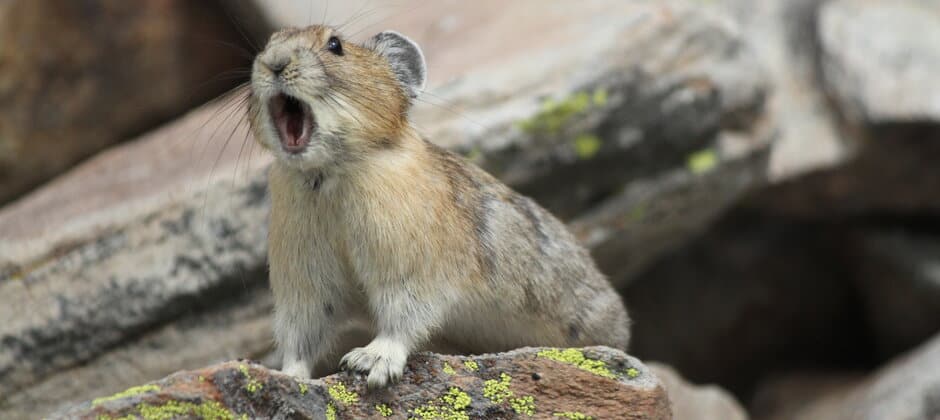Share this article
Climate change affects pikas even in unlikely areas
Climate change is driving American pikas upslope throughout much of their range. That appears to be true even in the Northern Rockies, where researchers thought they might be buffered by a relatively wetter, colder climate.
When Peter Billman was looking for a master’s project at Montana State University, his advisor, Erik Beever, pushed him to work in the Great Basin. Beever often works on American pika (Ochotona princeps) research with the U.S. Geological Survey, and he knew the species there was shifting upslope and populations were collapsing.
Not a fan of the Great Basin’s warm weather, Billman began noticing anecdotal effects of climate change in the Northern Rockies on plants and other organisms. He had an inkling that pikas there may be affected, too. “I had to justify to Erik for a solid year that the Northern Rockies had this huge research gap,” he said.
After getting his way, Billman, now a PhD candidate at the University of Connecticut, led a study published in Global Change Biology looking at if climate change was impacting pikas along the Continental Divide between Montana and Idaho—the only two states in their range where pikas are not listed as a species of conservation concern.
Billman and his colleagues examined four different mountain ranges and a total of 64 watersheds trying to get as much variation in vegetation and landscape as they could. Using satellite imagery, they located 12 talus patches—the boulder-strewn slopes where pikas spend their time—and documented them from the peak to the valley edge. Each morning and afternoon, when it was cool enough for the pikas to be out, the researchers detected and recorded pikas. Even areas that pikas no longer used still held old fecal pellets that hinted at historical occupancy.
Using fine-grained data on factors like temperature, precipitation, snowpack down to the day, they set out in search of correlations between climate and pika occupancy or abundance at 760 different sites. They also wanted to see if the predictors were the same for occupancy and abundance, which is often believed to be the case but rarely tested.
Billman and his colleagues found that American pikas were disappearing from lower elevations. They probably weren’t dispersing elsewhere, Billman said. Lower-elevation populations were most likely dying out. About a third of the patches were no longer occupied by pikas. That’s a low occupancy compared with places like Glacier National Park, where pikas occupy about 80% of the talus patches, or Yellowstone National Park, where they occupy about 98%.
Researchers found summer heat stress was the strongest mechanism impacting the animals. “Pikas can’t thermoregulate very well,” Billman said. “They have a hard time dissipating heat.” Summer days over 26 degrees Celsius resulted in lower abundance and greater range retraction. Ironically, cold stress was also a factor, likely due to warmer winters resulting in a less insulating snowpack. “That’s a bad sign in the face of climate change,” he said. “The Northern Rockies are expecting warmer summers and warmer winters.”
Billman said the region wasn’t as much of a stronghold for the species as scientists previously thought. He has already been in contact with agencies in Montana and Idaho to potentially consider pikas as a Species of Conservation Concern there.
The next thing to look at would be if pikas at lower elevations have warm adaptations that may be helpful for future conservation efforts. “We don’t have evidence of that, yet but low-elevation populations may indeed have some adaptive benefits to help other populations.” At the same time, populations at lower elevations have been found to be more inbred in other studies, such as in the North Cascades of Washington, he said.
Billman said he hopes research on pikas will also help shed light on how climate change is affecting other species. “We use this model species in hopes to illuminate the ‘how’ and ‘why’ mechanisms that may be influencing other species as well on the landscape,” he said.
Header Image: Even in areas where researchers thought pikas were doing fine, they are being impacted by climate change. Credit: Peter Billman








